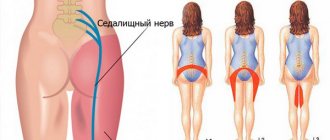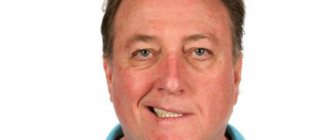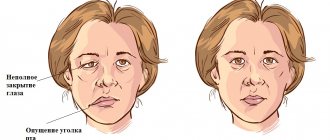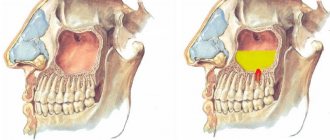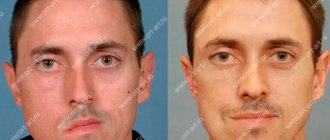Preparation and tasks of massage
Before starting a course of treatment, it is necessary to undergo an examination by a neurologist, an ENT specialist, an ophthalmologist, donate blood for a general analysis, and undergo an X-ray of the skull. The results of the examination make it possible to exclude a tumor, otitis media and other diseases with damage to the facial nerve, in which massage is ineffective.
A massage therapy course solves the following problems:
– improves blood circulation in the face, neck and collar area;
– restores the function of facial expressions and speech;
– prevents contractures, if present – reduces manifestations.
Symptoms
Manifestations of the disease occur acutely, within a few hours, for a maximum of 3 days. The gradual appearance of signs is most typical of compression of the nerve by a tumor growing from the surrounding tissue.
Depending on the severity, neuritis of the facial nerve is accompanied by the following symptoms:
- movements of the facial muscles are weakened, up to barely noticeable, disruption of conjugate contractions of symmetrical areas of the face;
- facial asymmetry, even disfiguring;
- difficulty closing the eyes; in severe cases, the palpebral fissures do not close completely;
- disorders of swallowing, chewing, speech;
- when the disease is complicated by keratitis, vision loss gradually develops;
- taste disturbance, weakening or strengthening of sound sensations;
- lacrimation;
- with simultaneous damage to the trigeminal nerve - severe pain in the facial area.
Signs of intoxication and fever are uncharacteristic and usually occur due to the infectious nature of neuritis of the facial nerve.
Indications and contraindications
A course of massage therapy for facial neuralgia is prescribed in the following cases:
– for neuritis caused by infection;
– after surgical removal of tumors compressing the facial nerve;
– after rehabilitation of acute purulent inflammation of the middle ear.
Before removing the cause of neuritis (tumor, inflammation), massaging the paresis is contraindicated.
Diagnostics
Treatment of facial nerve neuritis is prescribed after an examination, which includes:
- general blood and urine tests, blood glucose levels;
- if the infectious nature of the disease is suspected (Lyme disease, HIV infection, syphilis and others) - appropriate serological tests;
- if sarcoidosis or brucellosis is suspected, chest X-ray;
- in the case of a prolonged course (more than 3 weeks), if damage to the brain stem or cerebellopontine angle is suspected, MRI is prescribed, and if the pathological process is localized in the area of the temporal bone, computed tomography is more informative;
- Electroneuromyography is used to assess the effectiveness of treatment;
- If a nerve tissue infection is suspected, a lumbar puncture and cerebrospinal fluid examination are performed.
If the patient has already been diagnosed with ear diseases, or has discharge from the ear canal or hearing loss, he should definitely consult an ENT doctor.
Facial neuritis is differentiated from Lyme disease, Ramsay Hunt syndrome, Melkersson-Rosenthal syndrome.
Method of treating facial neuralgia using massage
The course of treatment is divided into three stages, established in accordance with the objectives.
- At the first stage (first 7 days) of the disease, when movement in the affected half of the face is absent or weakly expressed, attention is paid only to the healthy side. The patient is taught to relax the muscles at rest, after speaking, and then during speech. In addition, the amplitude of facial expressions of the unaffected half is limited.
- At the second stage, when muscle activity appears, attention is paid to the affected side, limiting the activity of healthy muscles.
- The third stage is characterized by residual effects in the form of muscle weakness and insufficient motor coordination.
Since nerve functions return unevenly, movements are not restored at the same time. In some cases, the lower half begins to function first, in others – the upper. Uneven recovery is fraught with the occurrence of contractures, so it is not recommended to force events with the help of massage and exercises.
Therapeutic gymnastics for facial muscles
When performing exercises with facial muscles, you must adhere to the following rules:
- Exercises are performed in front of a mirror. Before each exercise, relax the facial muscles, especially on the healthy side. It is not allowed to perform gymnastics only on the affected half, as this may impair general motor coordination.
- It is necessary to make symmetrical movements. The range of motion of the half of the face not affected by neuralgia is limited by holding it with the hand.
- The affected half of the exercise is performed passively, helping with one hand. When motor functions appear, the effect increases. As they are restored and activated, the same exercises are performed, creating resistance with the hand.
- Exercises for facial expressions are repeated 4–5 times with breaks, for eyes – 2–3 times. Gymnastics are performed 2-3 times daily.
- In the absence of full facial expressions, muscle movements of the healthy side are limited in order to mask the defect.
In case of complications of the disease, at the first signs of synkinesis (friendly movements), massage is limited, excluding physical activity for 3-5 days.
- To treat residual effects (severe contracture, synkinesis), before the massage session, a thermal procedure is performed using Sollux, paraffin, and poultices. Massaging should be stroking and rubbing.
- Kneading and vibration movements are contraindicated. When fixing the correct position, bandages with adhesives are used.
Duration of treatment
Massage procedures are carried out every day for 14–21 days, achieving complete recovery. The procedure lasts from 5 to 12 minutes.
If the expected effect is not achieved, massage sessions are suspended for 8–10 days, after which a new course of 25–30 procedures is established. Therapeutic gymnastics are performed at the same time.
Massage is combined with all types of medicinal and physiological therapy (electrophoresis, electrical stimulation using galvanic or exponential current, electroUHF, diathermogalvanization, darsonvalization, inductothermy, as well as applications with therapeutic mud, paraffin and mountain wax). Ultrasound treatment is carried out on the day of therapeutic exercises, alternating with the day of massage.
Massage techniques
For neuritis, several massage techniques are used, as well as a set of special exercises. Regardless of the chosen technique, the main movements are performed in the directions of the massage lines. The use of amplification techniques, as well as tapping and effleurage, is prohibited.
Segmental
Carrying out segmental massage aims not only to strengthen facial muscles, but also to relieve swelling and congestion in the nerve canal, as well as improve the conductivity and excitability of nerve endings. The massage technique for neuritis includes several techniques:
- vibrating soft movements;
- light stroking massage with fingertips;
- trituration;
- stroking.
All movements of the massage therapist should be light, without pressure. If there are no concomitant inflammatory diseases, then additional use of a vibrating massager is possible.
A segmental massage session for the treatment of neuritis begins with massaging the forehead. The forehead is stroked with an open palm from the central point to the temples, after which it is carried out with light rubbing. Vertical strokes are carried out from the eyebrows to the hairline. After stroking, apply light pressure with your fingers from the central point to the temples. Then they repeat the strokes and move on to vibrational patting of the entire surface of the forehead.
After the forehead, massage the area around the eyes. Using your fingers, they pass from the outer corner of the eye along the lower edge to the inner one. Use the middle and index fingers to lightly touch the upper eyelid. Then, with pointed circular movements, massage the outer edge of the eye socket, the lower edge towards the inner corner of the eye and the area above the eyebrows.
Move on to massaging the lower jaw, nose and lips. Usually the massage begins with the healthy half of the face, and gradually moves to the affected half. Techniques for this area are carried out using the index and middle finger along lines from the middle of the chin to the wings of the nose, along the sides of the nose to the bridge of the nose, along the back of the nose to its tip. Sequence of techniques:
- horizontal rubbing;
- vertical rubbing;
- point pressure;
- light point pressure;
- stroking;
- pincer-like stroking.
Finish the session by massaging the cheeks. The entire area is stroked with the palm of the hand, then rubbed linearly. Next they do:
- circular acupressure;
- forceps massage;
- zigzag stroking;
- point pressure with fingertips;
- tingling;
- light patting;
- horizontal active stroking.
All techniques alternate with soft relaxing strokes. The use of segmental massage in the treatment of neuritis requires a gradual increase in the load on the muscles. The first introductory sessions are always carried out in a gentle mode, selecting the optimal force of influence.
Spot
Acupressure facial massage is a simple but effective technique that is also suitable for independent use. The technique uses the impact of the surface of the fingers on biologically active points on the body, which are the projection of organs and systems. For neuritis of the facial nerve, massage is performed at the following points:
- between the eyebrows. The point is massaged for several minutes for pain, fatigue, or decreased concentration;
- below the inner edge of the eyebrows. The area is massaged to relieve nasal congestion, nerve pain and improve vision;
- above the corners of the lips. The points are massaged to relieve symptoms of stress;
- on the back of the neck along the spine. Massaging the points helps eliminate the symptoms of nerve inflammation, get rid of headaches, eye pain, and migraines;
- 2 cm above the auricle. Massage of the point relieves headaches and helps with neuritis of the auricular nerve.
After the massage, it is recommended to rest for a few minutes and do 2-4 breathing exercises . Do not perform acupressure if you have high blood pressure or chronic diseases of the cardiovascular system.
Self-massage
At home, self-massage of the face is carried out using the classical method. Facial massage consists of several basic techniques:
- circling with fingertips;
- circling with fingertips;
- tingling.
All techniques are performed first on the muscles of the healthy half of the face.
The session begins with pinching at the base of the nose, gradually moving along the eyebrow line to the temples. Then pinching passes along the lower jaw from the midpoint of the chin to the bottom of the ears. Next, the face is massaged in circular movements with minimal pressure. Massage techniques affect the side of the nose, forehead, hairline area, temples, and chin. Then intense circular movements are made through the cheekbones to the temples. With slight reinforcement, they pass along the sides of the nose to the lower edge of the cheekbones and to the ears. Next, the pads of the middle fingers are pressed to the inner corners of the eyes and slowly move them towards the ears. The forehead is massaged with circular, slow and sliding movements.
The session is completed by massaging the entire surface of the head and face. They pass from the temples behind the ears to the back of the head, massaging the forehead, chin, cheeks, and the front surface of the neck with light pressure.
Consequences and complications
Treatment must be started as quickly as possible, because
a year after the onset of the disease, the muscles will completely atrophy and their functionality cannot be restored. Complications may occur if therapy is not started at the first signs of the disease. With a long course of the disease, contracture of the facial muscles may occur, which is very difficult to restore. Disturbances in the sense of taste, visual disturbances (blindness, corneal ulcer), spasm of the muscles of the face and eyelid may occur. Consequences after the disease in some cases can last a lifetime.
Prevention of neuropathy
No one is immune from the appearance of unpleasant and painful symptoms of neuropathy. Inflammatory processes, brain diseases and even ordinary hypothermia can cause the appearance of one of the forms of neuralgia: inflammation of the trigeminal nerve. To avoid illness, you need to adhere to the rules of a healthy lifestyle:
- Eat rationally and balanced;
- Temper the body;
- Exercise;
- Avoid hypothermia and sudden temperature fluctuations;
- Do not use air conditioning for a long time in hot weather.
It is also important to consult a doctor in a timely manner to prescribe adequate treatment for diseases of the ear, nose and throat. During treatment, follow all doctor's recommendations and strict bed rest.
Self-massage for facial neuritis
In cases where it is not possible to use the help of a specialist, you can resort to self-massage techniques. First you need to choose a convenient place for the procedure. Any chair with a backrest that needs to be placed in front of a mirror will do. Perform the massage in the following sequence:
- Sitting on a chair with a straight back, begin with neck stretching exercises, tilting your head forward and back, as well as to the sides.
- Start massaging the forehead area with light stroking movements.
- Close your eyes and use the same movements to massage your eyelids from the inner corner of your eye, moving towards your temple.
- Apply light pressure with your fingertips and work with these movements in the area from the wings of the nose to the ear.
- Using light stroking massage movements, move from the lip area to the corner of the jaw.
- Work on the chin area, stroking from the midline to the corner of the lower jaw.
